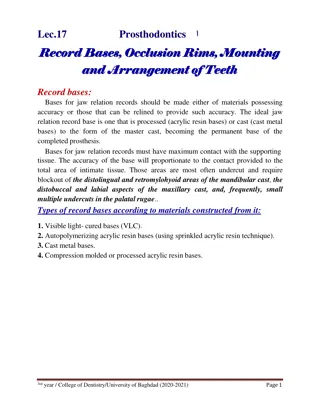Evolution of Prosthetic Technology and Design Through History
Explore the evolution of prosthetic technology from ancient times to modern innovations, focusing on improved functionality, engineering advancements, and design considerations for artificial limbs. Learn about the history, working principles, components, types, materials, and categories of modern prostheses.
Download Presentation

Please find below an Image/Link to download the presentation.
The content on the website is provided AS IS for your information and personal use only. It may not be sold, licensed, or shared on other websites without obtaining consent from the author.If you encounter any issues during the download, it is possible that the publisher has removed the file from their server.
You are allowed to download the files provided on this website for personal or commercial use, subject to the condition that they are used lawfully. All files are the property of their respective owners.
The content on the website is provided AS IS for your information and personal use only. It may not be sold, licensed, or shared on other websites without obtaining consent from the author.
E N D
Presentation Transcript
No More Peg Legs and Hooks Better Prosthetic Design through Engineering
History of Prostheses Used in Greek and Roman times Prosthetic toe found on 3000-year-old Egyptian mummy Before 1840s, few survived amputation and prosthetic supplies were often scavenged Surgery advances (anesthesia in 1842) > more precise surgeries and better prosthetic fit So many amputees from WWI and WWII increased the need for better prosthetic designs
How Do Prostheses Work? Purpose and benefits: To restore functionality and capabilities of lost limb Enables patients to regain mobility, conduct daily living activities, keep a job Engineering design considerations: Location (at a joint? cosmetic vs. functional?) Strength vs. weight Attachment method Available materials Cost Which hand is a prosthesis?
Parts of a Prosthesis 1. Interface (socket): Where the prosthetic device meets the remaining part of the limb Usually includes a suspension system that uses an attachment method: A suction valve forms a seal with the limb Locking pin Belt and harness 2. Components (pylon):The internal working parts of the prosthesis 3. Foot:Or hand, in the case of an arm prosthesis 4. Cover:May be covered in a material so more lifelike
Main Types of Artificial Limbs 1. Transradial: Replaces an arm from below the elbow (includes the wrist, hand and fingers) 2. Transhumeral: Replaces an arm from above the elbow (includes the elbow, wrist, hand and fingers) 3. Transtibial: Replaces the leg from below the knee (includes the ankle, foot and toes) 4. Transfemoral: Replaces the leg from above the knee (includes the knee, ankle, foot and toes)
Modern Materials Modern materials make prostheses stronger, lighter and morerealistic in appearance and use: Advanced plastics Carbon fiber composites Electronic components for control A brain-controlled prosthetic limb
Categories of Modern Prostheses 1. Specialty 2. Functional
Categories of Modern Prostheses 3. Cosmetic Eye Fingers Leg
Controlling the Prosthetic External cable/switch control systems Electronic systems: Electrodes implanted in residual limbs (forearm in this example) control muscle movements Electrodes implanted into the brain (neural implants) provide residual limb muscle control via neuron signals
Biomedical & Mechanical Engineers Engineers apply their expert knowledge of: anatomy neurology biomechanics sensor motor control to design prostheses and other medical devices that improve mobility and function for people























